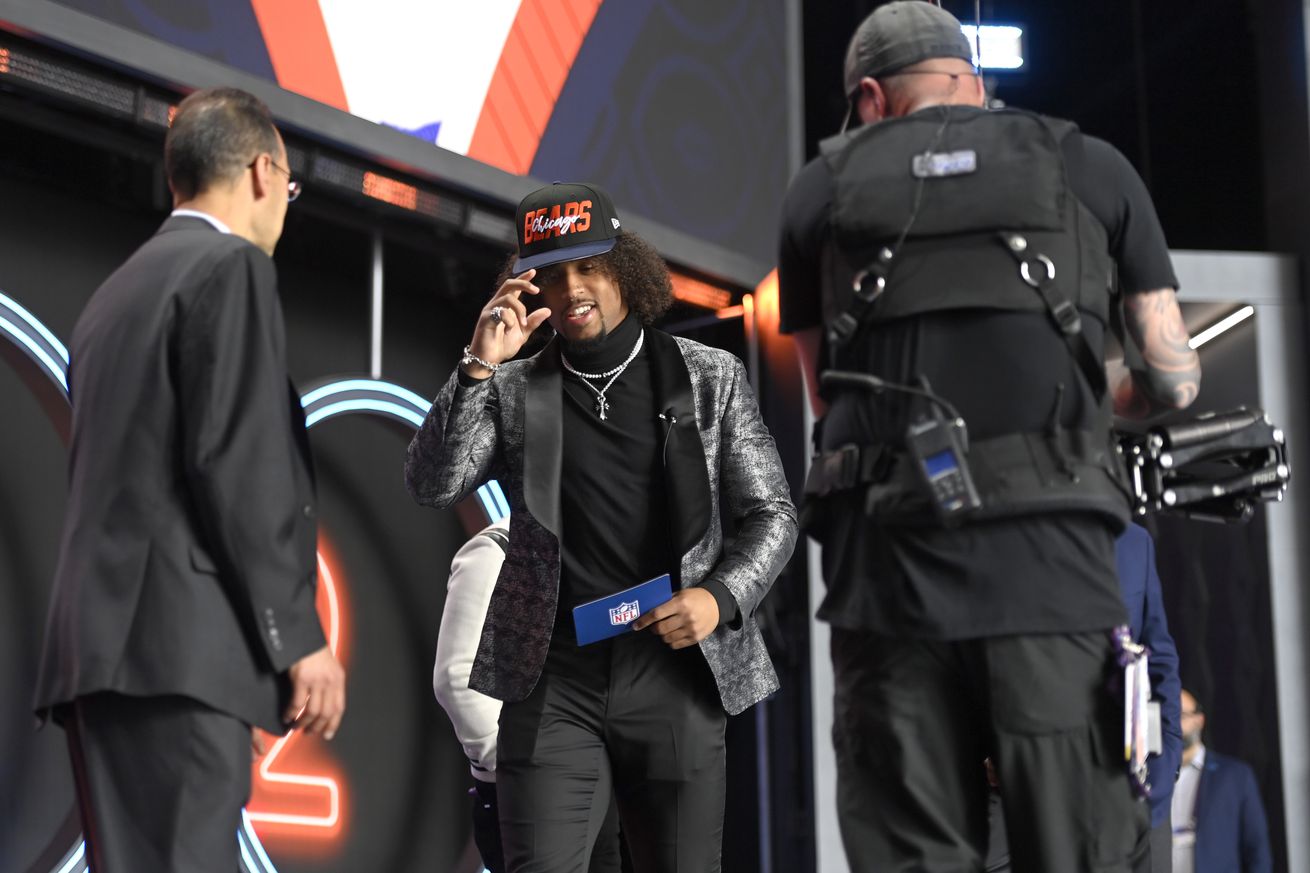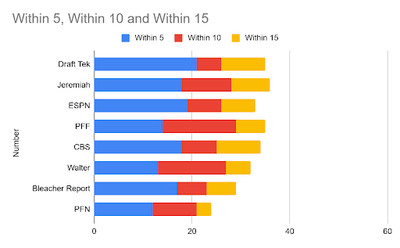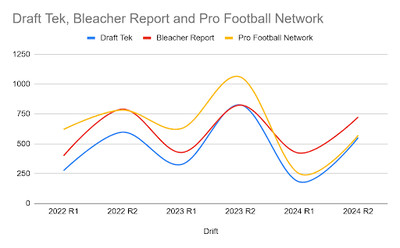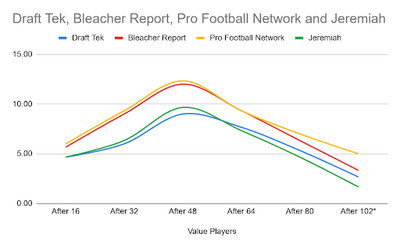
Draft rankings by experts are powerful educational tools and a lot of fun this time of year. However, besides in a small handful of cases, even the best board isn’t likely to do more than suggest the general round where a player might be drafted.
There are thousands of potential prospects in the NFL Draft, and each one will be weighed individually by 32 different teams (and each of those teams will have multiple layers of scouting and evaluation). It’s probably not an exaggeration to say that half a million “decisions” are made this time of year, coalescing on a few hundred candidates. That outsiders looking in can recover the process at all is amazing. However, a surplus of information (some of it of dubious quality) can make people overconfident that they know how things are going to go. People will be tricked into speaking with authority about which prospects might or might not be drafted in which spots. It’s important to remember that besides painting general trends and concepts, apart from the very top these boards are likely more “wrong” than they are “right.” Or, more accurately, where a player is actually drafted is likely to have only a very slight resemblance to his position on any given board.
I was reminded of this when I came across my “confidence board” from 2023, explained here.
In simple terms, I used to always put together a consensus board of multiple “draft boards”, trying to assess how different prospects were viewed in an effort to reduce reliance on any one source of information. I made the mistake of looking at that board and asking myself how closely it aligned with what actually happened in 2023. The answer, put simply, was that when viewed through the lens of thousands of possible prospects, it aligned rather well. The tighter the focus, though, the less clear the alignment.
Instead of drawing massive conclusions, I wanted to use this as an opportunity to frame several questions I had about the overlap between what really happens in the draft and what expectations might be generated by pre-draft coverage.
Question #1 – How much “drift” is there between the actual draft and the pre-draft boards fans use?
One way of assessing accuracy is to simply see how far “off” from the eventual draft position each board happened to be and to add all these numbers together. Back in building the old consensus board, I assigned all players not in the original “Top 100” board a value of 101 for that board, and while that will tend to render each board more accurate than it really was, it’s close enough to get a sense of whether or not these boards are even close to how NFL front offices view the pool of players drafted in the first two rounds.
Purely in terms of how generally the boards matched up with draft order, the ones with the least drift were Draft Tek, PFF and ESPN. They were all close enough to be tied given the crudeness of the methodology (ranging from 1117 total positions off to 1159 total positions off). In the next tier is CBS Sports and Bleacher Report (low-to-mid-1200s), with the least accurate being Daniel Jeremiah (1360), Walter Football (1478), and Pro Football Network (1651). However, that means that across the 63 prospects taken in the first two rounds of the 2023 Draft, the most accurate rater was off by an average of 17 draft spots, or half a round.
Some of that inaccuracy is driven by players who were simply surprises to everyone, or close enough. Nobody had Jonathan Mingo (#39 to the Carolina Panthers), Brenton Strange (#60 to the Jacksonville Jaguars), or Juice Scruggs (#62) in their top hundred–or top fifty, in the case of Jeremiah. Walter Football had Quan Martin at 20, but nobody else had him in the Top 100–even though he went 47th to the Commanders. Pro Football Focus had Luke Schoonmaker (#58 to the Dallas Cowboys) at 95, but that was the highest rank anyone in the group had on him.
By contrast, Antonio Johnson was in the Top 50 of everyone but Daniel Jeremiah, but he didn’t get drafted until #160. Kelee Ringo was overvalued by everyone, with an average rank of around 40th (exactly where Jeremiah placed him), but he didn’t go until #105. Pro Football Focus was the closest, but even they overvalued him by a full round (73rd).
Again, none of this is to say that these boards are wrong. They were accurate reflections of the quality of the players as those commentators saw them. However, thirty-two front offices seem not to have agreed.
Answer #1 – There is considerable drift, and while it varies from board to board, even boards with relatively low drift have little alignment with draft order.
Question 2 – How many times do the draft boards find and place players in roughly the spots they will be taken?
Multiple forces should cause the draft to tend toward matching draft boards if they accurately reflect significant differences in talent. Teams often speak of drafting the “best player available” and teams can trade up or down in order to seek out the players whose abilities they value. Some variation should be inevitable, but how often have the players who are drafted placed within 5, 10, or even 15 spots of relative rank on these draft boards? More than 15 spots suggests that it took half of the teams in the NFL to identify the player’s talent (and the other half had 15 opportunities to trade up for the right to draft him), and the “lore” around the draft is that when a talent falls, he presents too good of a value to pass up regardless of need.
A simple but effective scoring system offering 3 points for a drafted player within 5 ranks of his eventual position, 2 points for a player within 10 ranks, and 1 point for a player within 1 point was used to highlight some of the trends. This scoring system mean that each big board would be rewarded with at least 1 point for simply getting within half a round of the player’s final draft position, and so while a perfect score would be 189 (63 players drafted in the first two rounds, all found within 5 spots), a score of 63 would be if every player drafted in these rounds was only drafted within 15 spots of his rank.

Draft Tek (21/26/35) – Score 82/189: With 21 out of 64 of the top players drafted within five spots of their relative rank and 35 of 64 within 15 spots, Draft Tek was the most likely to reflect the actual draft order of any March board. Beside the usual suspects, they under-sold Jack Campbell, Sam LaPorta, Joe Tippmann, and Tuli Tuipulotu. They also oversold Cam Smith and O’Cyrus Torrence. To be fair, Torrence has turned out to be a solid player, so it is possible that they were “right” and the front offices were “wrong” – the true finding here is that they did remarkably well given all of the variables at play.
Daniel Jeremiah (18/28/36) – 82/189: Daniel Jeremiah was not included in the original consensus board because he just doesn’t rank enough players, but it is worthwhile to note that even though he just flat out didn’t include 19 of the players drafted in the first two rounds in his Top 50, he still got 28 players within 10 spots of their final draft position. Of note, he was the only one even close to the actual draft in his ranking of Joe Tippmann and Darnell Wright. Those two have played toward the top of their positional rankings and were undersold by the other experts, it seems. Given how poorly this evaluation system interfaces with how he does business, this is another indicator that Jeremiah probably deserves the praise he receives.
ESPN Best Available (19/26/33) – 78/189: ESPN’s big board saw 19 players drafted five spots or less away from their assigned rank, and just over half of the draft class drafted within 15 spots. Their biggest success was really that they got within about a half round on most of the players. If someone wanted to call this a good result, it would be hard to argue.
PFF (14/29/35) – 78/189: Honestly, PFF had a good showing in a number of ways. They were one of the few not to overvalue Peter Skoronski and they assessed Devon Witherspoon as the top corner in a class crowded with corners. Like Draft Tek, they placed a high value on Torrence. They did, however, tab both Will Levis and Bryce Young ahead of CJ Stroud, which in retrospect seems a little off–especially with them placing Levis and Richardson in their Top Ten players overall. They were really only hurt by their relatively low number of players placed within 5 spots. However, they also suffered from a tendency to overvalue the wrong quarterbacks and under-value running backs compared to the NFL.
I noted at the time that PFF was one of two outliers, and in their case they ended up placing toward the top of the mix in terms of accuracy measured in both directions, but not exceptionally high in either.
CBS (18/25/34) – 77/189: The last of the “more or less in alignment” crowd, CBS Sports did get more than half of the players in the first two rounds within 15 spots of their drafted order.
Walter Football (13/27/32) – 72/189: While Walter Football is a bit of an institution in the online prospect rating community, they did not see eye-to-eye with NFL teams in 2023. Of note, they tend to inflate the value of running backs and their offensive linemen ranks are out of alignment with other experts’ and (apparently) the NFL itself frequently.
Bleacher Report (17/23/29) – 69/189: Honesty compels me to admit that I had an inaccurate expectation that they would be toward the top of the “accurate enough for fans” board. This result surprised me, and taken with the sort of “mid” placement in terms of general drift, it’s a reminder to check my own biases. They are tied for the fewest players ranked within ten spots of their original position and are the second-worst in terms of players within 15 spots. This seems like a good time to place the reminder that this doesn’t mean that Bleacher Report was wrong, merely that their draft board reflected preferences that were not shared by the decision-makers in the draft.
Pro Football Network (12/23/26) – 61/189: One of the leading Mock Draft simulators was also the least comparable to the real draft in terms of how things turned out. They have the fewest players placed within 5 spots of their final position and they were tied for the fewest placed within ten spots. They were the worst at getting within 15 spots. They were also by a wide margin the least accurate overall in terms of gross accuracy. They were the other outlier in the group two years ago, and in their case they seem to have been the least “predictive” board because of it.
Answer #2 – The boards only crudely align with draft position, and even the ones in greatest alignment are still more like Rex Grossman chucking it and going deep than Drew Brees hitting targets like lasers.
Question #3 – Was 2023 just an outlier?
I was curious about whether or not trends would hold, or if this was just a blip. Not having infinite time, I narrowed my options down to Draft Tek (the “winner” of both categories), Pro Football Network (the “loser” of both categories), and Bleacher Report (to investigate my own bias). I looked only at 2022 and 2024, but I was forced to take more updated boards which might impact the overall ability for each board to be dialed in.
Draft Tek (53/79/93) – Score 225/384: To hone in on that 93 number a bit, this suggests that nearly three-quarters of players drafted in the top two rounds were placed more tightly than a half-round away from their actual draft spot, and a staggering 40% were placed within 5 spots. That’s…a lot better than I was expecting any board to do. Their total “positional deflection” score across these two years is only 1607 spots, or under 13 spots per selection.
Pro Football Network (39/55/68) – Score 162/384: This is a relatively poor showing, and added with the 2225 spots of deflection from the actual draft order (more than 17 spots per player), it doesn’t bode well for someone basing their certainly on “when a player will be drafted” on this board. Barely more than half of the picks were placed within 15 spots of their eventual draft position.
Bleacher Report (34/54/73) – Score 161/384: This is functionally a dead heat with Pro Football Network, which might be promising. However, they also had 2338 spots of deflection, or more than 18 spots from “true” per pick. They had fewer “close” hits than Pro Football Network, but they also had more in the general vicinity. Neither got anywhere near the alignment offered by Draft Tek.
Taken altogether, Draft Tek is far more likely to align with the real draft than the others across all three years (to the point that they have more players with 10 spots than the other boards have within 15, and they have almost as many players within 5 as the other boards have within 10).

Here are all three years’ worth of drift taken together, played out by round as well. Unsurprisingly, Round 1 is more “dialed in” than Round 2, and either 2024 shows greater alignment or just a more “predictable” draft. Also, the 2023 draft boards were a little farther from the actual draft than the other two years, which could reflect that they came from earlier in the draft cycle or could reflect a more unpredictable year. That merits future investigation.
Answer #3 – No, 2023 was not an outlier. The resemblance between draft boards and draft picks is moderate at best, but some boards (such as Draft Tek) seem to be much more likely to align than others.
Question #4 – What about the other way around? Where do “top players” on draft boards end up being taken? Does “best available” win out over other factors?
So far, I’ve been looking at it from the perspective of where the draft boards placed players who ended up being taken in the first two rounds. What about looking at it in terms of where the NFL eventually drafted the players these boards had ranked? Limiting myself to the top fifty players (so I can include Jeremiah), across the last three years where did the top players on each draft board end up getting taken (if at all)? How much drift was there, and how many of each board’s top players were left at key points in the draft?
First, as a whole, the drift is still pronounced and takes place in the usual order. Some form of “cap” is necessary to prevent a small handful of undrafted or low-drafted players from skewing the scores, all numbers are corrected to assume that no player can be more than 60 spots out of alignment (roughly two rounds), Draft Tek averages just over 14.25 spots of drift per player in their top 50, whereas Jeremiah is slightly under 14.5. Bleacher Report is a hair over 18 spots and Pro Football Network is a hair under 20 spots of draft per player.
Perhaps a better way of viewing it is this—how many “value” players are left at each place in the draft? In other words, halfway through the first round, how many players ranked in the top sixteen are going to be left? After the first round is over, how many players ranked in the top 32? And so on. This chart takes each of these four boards and then assesses how may players are “left behind” compared to their assigned ranking at each stage of the draft.

On a per-draft basis, over these three years, someone following the recommendations of Jeremiah or Draft Tek would find an average of 4.67 players with ranks in the top sixteen who were still available at the midpoint of Round 1. After Round 1 was over, though, there would be around six “value” players who one would think would be too good to pass up. Throughout Round 2 at different points, there would be 8-10 players who were ranked ahead of their draft position, still. Somewhere at the end of Round 2, Jeremiah starts to align more with the NFL front offices for the first time. Even at the midpoint of Round 3, there would be five players who “should not have lasted” this long. Even after the average number of compensatory third-round picks have been made, there might be two or three guys left from each board’s Top 50.
The difference between draft boards and the draft is more pronounced with Bleacher Report and Pro Football Network. For example, after two rounds of drafting, each of these boards would still have around 9 players left from their Top 50 waiting for their phones to ring.
Answer #4 – While a majority of the top prospects on each draft board go at or around their positions of relative rank, even through three rounds of the draft there are a few players who at least one expert (and probably more) liked far more than 32 GMs, and halfway through the second round, there might be a dozen players “too valuable” to pass up who are passed up by the team on the clock.
Question #5 – So what’s the point?
One of the first things I learned as a hiker was that the map was not the region. Relying on a map without being aware of your surroundings can lead you to washed out bridges, rockfalls, and frustration. Likewise, draft boards are incredible tools to get to know individual prospects, and to offer insight into who might be a few of the best available players at given positions. However, even with 32 teams with varied needs, there is little reason to think that there is “no way” a highly touted player just cannot fall. Another way of looking at it, though, is that if these highly-ranked players are being skipped, that means that other players must be getting selected ahead of them.
Many mock drafts are available, and while such tools are frequently evaluated as “best” or “worst”, and while that is an interesting exercise, the purpose here is different. If there is a point to any of this except curiosity (a valid impulse in my mind), it is to show that the draft resembles football itself.
We can write out who has a better quarterback, whose corner has the highest EPA allowed, and which defensive tackle is the most likely to generate a sack. The game still needs to be played, and there are still upsets. Even the board in this group that is the most aligned with the collective thinking of the NFL will have a dozen points of variation from the norm. GMs fumble, too, only in their case it’s a trade and not a football. Scouts also connect on Hail Mary passes, only instead it’s the ability to find the gem that others have overlooked.
Answer #5 – The best draft board is one that introduces fans to players’ strengths and weaknesses. Ranking is probably much less important, and far less reliable, than many would like to believe.